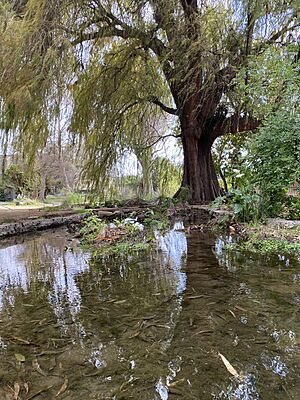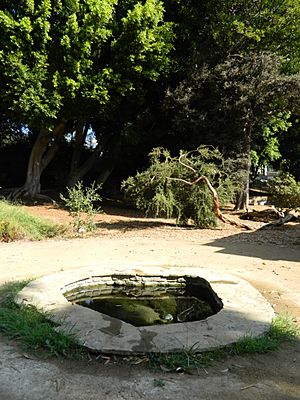Tongva Sacred Springs facts for kids
Quick facts for kids Tongva Sacred Springs |
|
|---|---|
| Native name Koruuvanga | |
 |
|
| Location | University High School, Los Angeles |
| Reference no. | 522 |
The Tongva Sacred Springs are special water sources found at University High School in Los Angeles, California. For thousands of years, these springs have provided fresh water. The native Tongva people called them Koruuvanga. They have used these springs since at least 500 BC. Even today, the springs produce a lot of water, about 22,000 to 25,000 gallons (83,000 to 95,000 liters) every day! People sometimes call them the Gabrieleno-Tongva Springs or the Sacred Springs.
You can find the springs in two main spots on the school campus. The biggest group of springs is a special area cared for by the Gabrielino/Tongva Springs Foundation. For a long time, this part of the campus was called the "horticultural" or "agricultural area." It even has a small lagoon about 80 square feet (7.4 square meters) in size. Another spring creates a lovely man-made waterfall at the edge of the upper athletic field. There used to be a third spring, but it stopped flowing in the 1940s when a local water company started taking water from the underground water source. All the water from the springs that are still flowing goes into Santa Monica Bay.
History of the Springs
The name Kuruvungna means "a place where we are in the sun." This was the name of a village located right where the springs are. In 1769, the Portolà Expedition camped at this village. This expedition was important because it helped lead to the founding of Los Angeles. The Tongva people were very welcoming. They gave the travelers watercress, chia seeds, and fresh water from the springs.
A person named Juan Crespí, who was with the Portolà Expedition, wrote about the Tongva people in his diary. He described them as "very friendly, compliant tractable heathens." They lived in houses with grass roofs. They brought gifts like seeds and sage to the expedition's captain.
The springs were once called "San Gregorio" by Crespí. The soldiers with him called them "El Berrendo" after they wounded a deer there. Later, around the early 1800s, the springs became known as "The Tears of Santa Monica." This name made people think of the saint crying for her son. The name "Santa Monica" was first officially used for the area in 1827.
In 1839, the Kuruvungna Springs became part of a large piece of land called Rancho San Vicente y Santa Monica. This was the first time the springs were "owned" by anyone other than the native people. The son of the rancho's owner lived in a house nearby, overlooking the springs. Today, many places like the canyon, the city, the bay, and even the freeway are named after the former name of Kuruvungna Springs. In the 1800s, these springs were the main water supply for the city of Santa Monica.
University High School and the Springs
When construction began for Warren G. Harding High School (which later became University High School) in 1925, workers found signs of an ancient Native American village. The school decided to make the springs a special part of the campus. The water from the upper spring was made to flow down a small waterfall, which you can still see today.
The lower springs were left open so people could see the water bubbling up from the sand. The extra water fills a large pond with a small island. This pond used to be a popular spot for students and for graduation photos. However, in the 1980s, the area around the springs became neglected and was used as a dump.
In the 1990s, the Gabrielino Tongva Springs Foundation stepped in. They removed tons of trash and planted native plants like tule reeds around the springs. In 1975, students and a teacher found a small skeleton and soapstone bowls. Archaeologists now believe this was a burial site. In 1980, Indian Springs Continuation High School opened on the part of the campus where the springs are located.
In 1992, there was a plan to build an underground parking lot nearby. This would have stopped the springs from flowing. In response, descendants of the Tongva tribe, community members, teachers, and students formed a group called the Gabrielino/Tongva Springs Foundation. After a two-year effort, the parking lot plan was stopped.
Today, the foundation takes care of the site. They hold monthly ceremonies and guided tours there. They also received a grant to plant more native trees, vines, and herbs in the area.
Since 1992, the Gabrieleno Springs Foundation has hosted an annual "Life Before Columbus Day" event. This event happens every year before Columbus Day. It celebrates the history of the land and the Tongva people. Many people attend, including Native Americans from different tribes, local leaders, and students. The event includes tours of the Kuruvunga Village site and springs. There are also performances by dancers from the Tongva and Aztec tribes, and storytelling from the Chumash tribe. Kids can also enjoy hands-on activities like making corn-dolls, painting rocks, and making tortillas.
In 1998, Governor Pete Wilson signed a bill called SB 1956. This bill, introduced by Senator Tom Hayden, asked the California Department of Parks and Recreation to help create a permanent cultural and ecological site at the Gabrielino/Tongva Springs. It also called for a special group to plan how to protect the springs and the land around them. The bill provided $50,000 to help with this important work.
California Historical Landmark
The Tongva Sacred Springs are recognized as a special historical place. A marker at the site says:
NO. 522 SERRA SPRINGS - The Portolá Expedition of 1769 encamped at this spring, and it is reported that in 1770 Father Serra said Mass here to the Indians of this area. This spring was also the former water supply of the town of Santa Monica. The site is now the campus of the University High School.
The springs are officially known as California Historical Landmark #522.



